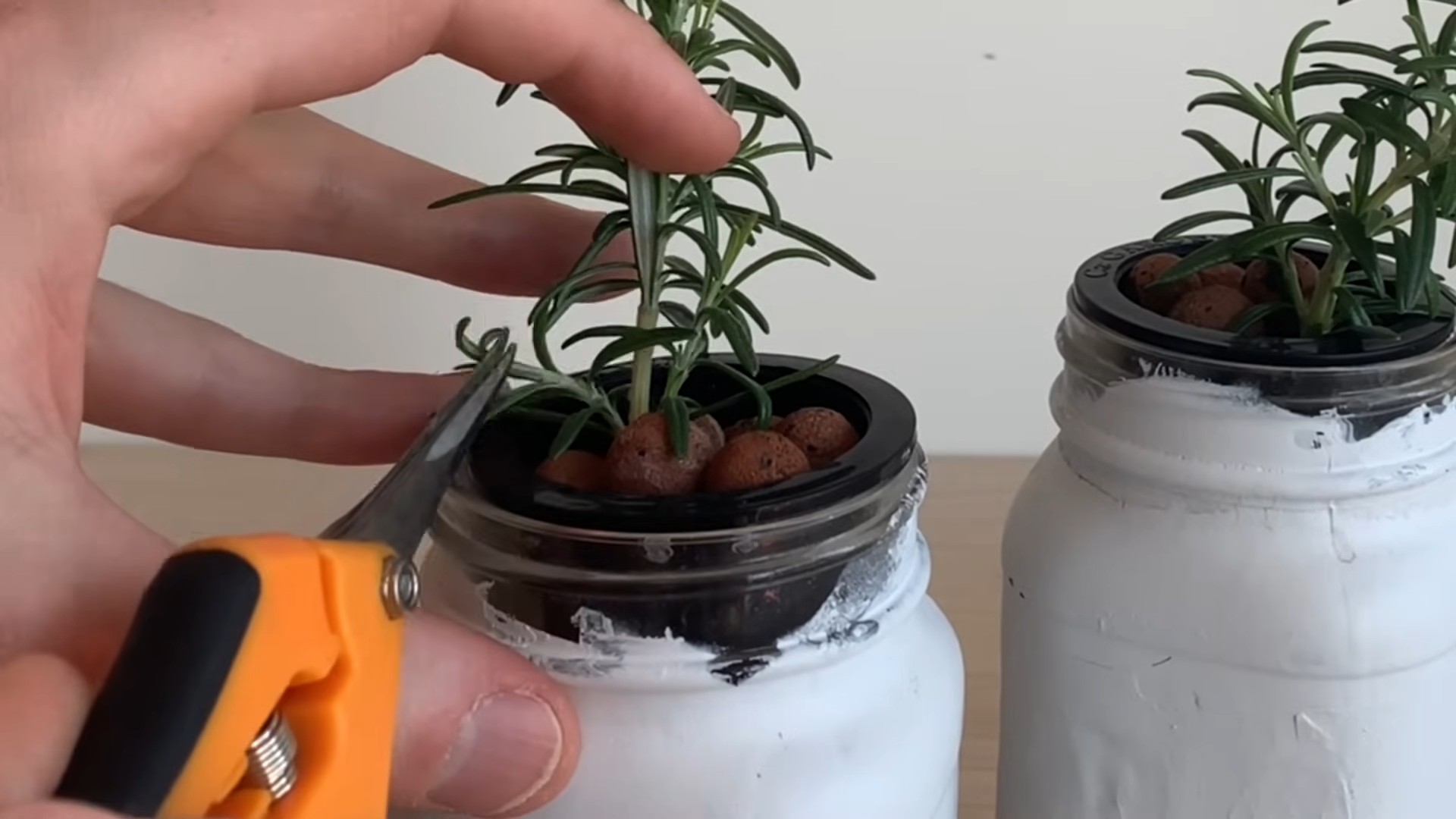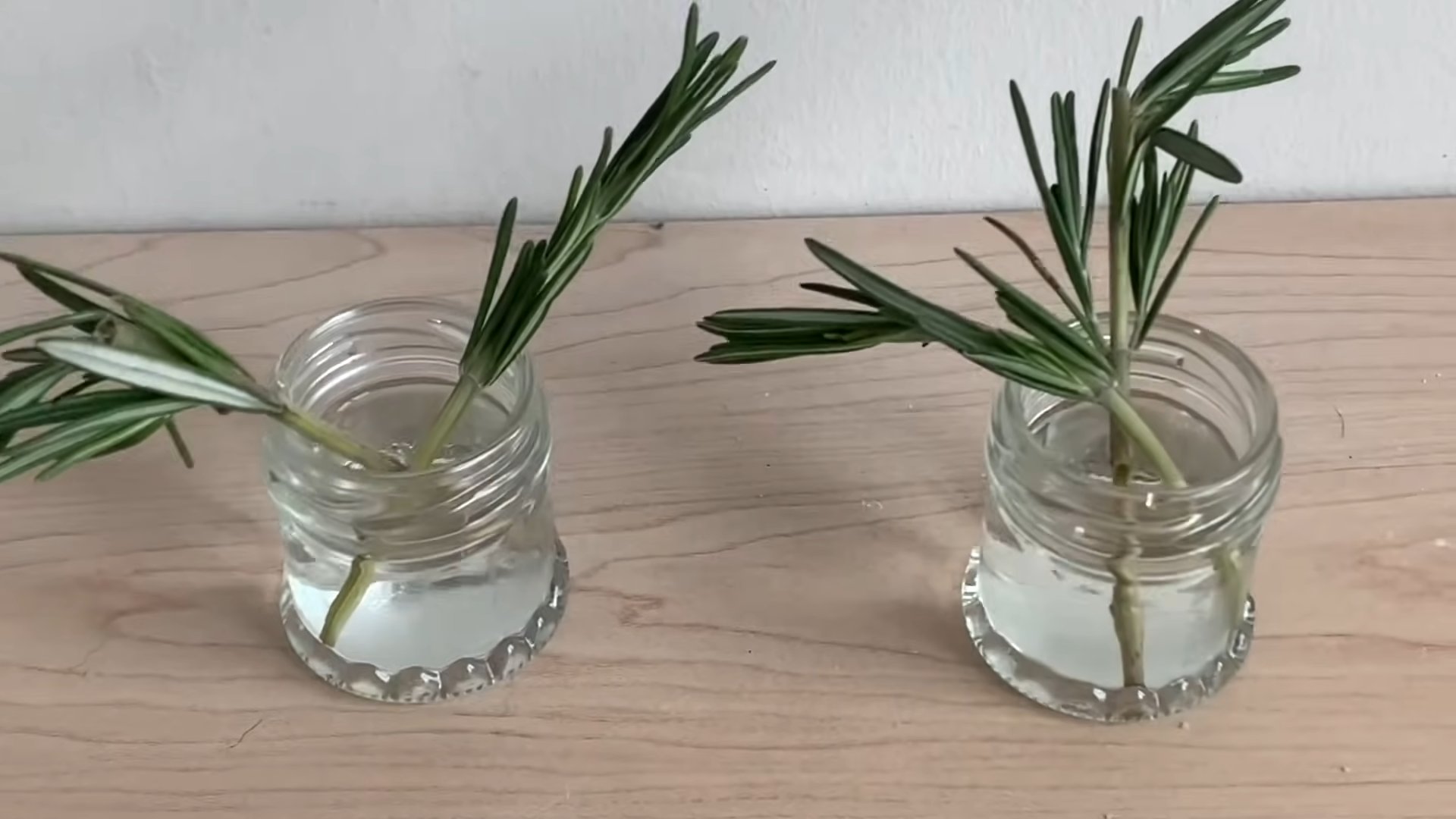Grow rosemary indoors? Absolutely! Imagine stepping into your kitchen and snipping fresh, fragrant rosemary to elevate your culinary creations, even in the dead of winter. No more sad, dried-up herbs from the grocery store! For centuries, rosemary has been cherished not only for its culinary uses but also for its medicinal properties and symbolic significance, representing remembrance and love in various cultures. From ancient Greece, where students wore rosemary garlands to improve memory, to modern-day aromatherapy, this herb boasts a rich history.
But let’s be honest, keeping rosemary alive indoors can feel like a Herculean task. It often ends up looking sad and leggy, a far cry from the thriving plant you envisioned. That’s where these DIY tricks and hacks come in! I’m going to share my secrets to successfully grow rosemary indoors, ensuring you have a flourishing herb garden right on your windowsill. We’ll cover everything from choosing the right pot and soil to providing the perfect amount of light and water. Get ready to transform your indoor space into a fragrant oasis and enjoy the delightful benefits of fresh rosemary year-round!

Growing Rosemary Indoors: A Comprehensive Guide
Hey there, fellow plant enthusiasts! Ever dreamt of having fresh rosemary at your fingertips, ready to spice up your culinary creations? Well, you can! Growing rosemary indoors is totally achievable, and I’m here to guide you through every step. It might seem a little daunting at first, but trust me, with a little patience and the right know-how, you’ll be harvesting your own fragrant rosemary in no time.
Choosing the Right Rosemary Variety
Not all rosemary varieties are created equal, especially when it comes to indoor growing. Some are more compact and better suited for containers than others. Here are a few of my favorites:
* ‘Blue Boy’: This is a classic choice, known for its compact size and beautiful blue flowers. It’s relatively easy to care for and tolerates indoor conditions well.
* ‘Roman Beauty’: Another compact variety, ‘Roman Beauty’ has a slightly weeping habit, making it a lovely addition to a hanging basket or a pot on a shelf.
* ‘Arp’: This variety is known for its exceptional cold hardiness, but it also thrives indoors. It has a slightly more upright growth habit than the others.
Getting Started: What You’ll Need
Before we dive into the planting process, let’s gather all the necessary supplies. Having everything on hand will make the whole experience much smoother.
* Rosemary Plant or Cuttings: You can either purchase a small rosemary plant from a local nursery or propagate your own from cuttings (more on that later!).
* Pot: Choose a pot that’s at least 6 inches in diameter and has drainage holes. Rosemary doesn’t like sitting in soggy soil. Terracotta pots are great because they allow the soil to breathe.
* Well-Draining Potting Mix: Rosemary needs well-draining soil to prevent root rot. A mix specifically formulated for herbs or cacti/succulents works perfectly. Avoid using garden soil, as it’s often too heavy.
* Grow Light (Optional but Recommended): Rosemary needs a lot of sunlight, and if you don’t have a sunny windowsill, a grow light will be your best friend.
* Watering Can: A watering can with a long spout will help you water your rosemary evenly without splashing the leaves.
* Pruning Shears or Scissors: You’ll need these for harvesting and pruning your rosemary.
* Fertilizer (Optional): A balanced liquid fertilizer can help boost growth, but it’s not essential.
Planting Your Rosemary
Now for the fun part! Let’s get your rosemary planted and ready to thrive.
1. Prepare the Pot: Fill the pot with your well-draining potting mix, leaving about an inch of space at the top.
2. Plant the Rosemary: Gently remove the rosemary plant from its nursery container. If the roots are tightly bound, gently loosen them with your fingers. Place the rosemary plant in the center of the pot, making sure the top of the root ball is level with the soil surface.
3. Fill in the Gaps: Add more potting mix around the rosemary plant, gently pressing down to secure it in place.
4. Water Thoroughly: Water the rosemary plant thoroughly until water drains out of the drainage holes. This will help settle the soil and ensure the roots are properly hydrated.
5. Find a Sunny Spot: Place your newly planted rosemary in a sunny location that receives at least 6-8 hours of direct sunlight per day. A south-facing window is ideal. If you don’t have enough natural light, supplement with a grow light.
Propagating Rosemary from Cuttings (Optional)
Want to expand your rosemary collection without spending a fortune? Propagating from cuttings is a fantastic way to do it!
1. Take Cuttings: In the spring or early summer, take 4-6 inch cuttings from new growth on a healthy rosemary plant. Use clean pruning shears or scissors to make a clean cut just below a leaf node (the point where a leaf grows from the stem).
2. Prepare the Cuttings: Remove the leaves from the bottom inch or two of each cutting. This will prevent them from rotting when they’re in the soil.
3. Rooting Hormone (Optional): Dip the cut end of each cutting in rooting hormone powder. This will help stimulate root growth, but it’s not essential.
4. Plant the Cuttings: Fill a small pot with well-draining potting mix. Make a small hole in the soil with a pencil or your finger, and insert the cutting into the hole. Gently press the soil around the cutting to secure it in place.
5. Water and Cover: Water the cuttings thoroughly and then cover the pot with a plastic bag or humidity dome to create a humid environment. This will help prevent the cuttings from drying out.
6. Wait for Roots: Place the pot in a warm, bright location, but out of direct sunlight. Keep the soil moist but not soggy. After a few weeks, gently tug on the cuttings to see if they’ve rooted. If they resist, they’ve developed roots!
7. Transplant: Once the cuttings have rooted, you can transplant them into individual pots.
Caring for Your Indoor Rosemary
Now that your rosemary is planted and thriving, it’s time to learn how to keep it happy and healthy.
Watering
Rosemary is drought-tolerant and doesn’t like to be overwatered. Allow the soil to dry out slightly between waterings. When you do water, water thoroughly until water drains out of the drainage holes. Avoid getting the leaves wet, as this can lead to fungal diseases. I usually check the soil moisture by sticking my finger about an inch deep. If it feels dry, it’s time to water.
Light
As I mentioned earlier, rosemary needs a lot of sunlight. Aim for at least 6-8 hours of direct sunlight per day. If you don’t have enough natural light, supplement with a grow light. Place the grow light about 6-12 inches above the rosemary plant.
Temperature
Rosemary prefers temperatures between 60-70°F (15-21°C). Avoid placing it near drafts or heating vents, as this can dry it out.
Humidity
Rosemary prefers relatively low humidity. If your home is particularly humid, you may need to improve air circulation around the plant by opening a window or using a fan.
Fertilizing
Rosemary doesn’t need a lot of fertilizer. You can fertilize it once a month during the growing season (spring and summer) with a balanced liquid fertilizer diluted to half strength. Avoid fertilizing during the winter months when the plant is dormant.
Pruning
Pruning is essential for keeping your rosemary plant healthy and productive. Prune regularly to encourage bushier growth and prevent the plant from becoming leggy. You can prune your rosemary at any time of year, but it’s best to do it in the spring or early summer.
* Remove dead or damaged branches: This will help prevent the spread of disease.
* Pinch back the tips of new growth: This will encourage the plant to branch out and become bushier.
* Harvest regularly: Harvesting rosemary is a form of pruning! The more you harvest, the more the plant will grow.
Pest and Disease Control
Rosemary is relatively pest-resistant, but it can occasionally be affected by aphids, spider mites, or whiteflies. If you notice any pests, you can try spraying the plant with insecticidal soap or neem oil.
Root rot is the most common disease that affects rosemary. It’s caused by overwatering and poor drainage. To prevent root rot, make sure you’re using well-draining potting mix and avoid overwatering.
Harvesting Your Rosemary
The best part of growing rosemary indoors is being able to harvest fresh sprigs whenever you need them!
* Harvesting: Use pruning shears or scissors to cut off sprigs of rosemary. You can harvest up to one-third of the plant at a time without harming it.
* Using Fresh Rosemary: Fresh rosemary can be used in a variety of dishes, including soups, stews, roasts, and sauces. It can also be used to flavor oils and vinegars.
* Drying Rosemary: If you have more rosemary than you can use fresh, you can dry it for later use. To dry rosemary, tie sprigs together and hang them upside down in a cool, dry place. Once the leaves are dry and brittle, you can remove them from the stems and store them in an airtight container.
Troubleshooting
Even with the best care, you might encounter some problems along the way. Here are a few common issues and how to address them:
* Yellowing Leaves: This could be a sign of overwatering, underwatering, or nutrient deficiency. Check the soil moisture and adjust your watering accordingly. If the soil is dry, water thoroughly. If the soil is soggy, allow it to dry out completely before watering again.

Conclusion
So, there you have it! Growing rosemary indoors doesn’t have to be a daunting task. With a little patience, the right setup, and these simple DIY tricks, you can enjoy the fresh, aromatic flavor of homegrown rosemary all year round. Forget those sad, dried-out sprigs from the grocery store – imagine the vibrant, flavorful rosemary you can add to your roasted chicken, focaccia bread, or even a simple cup of herbal tea.
This isn’t just about saving money (although that’s a definite perk!). It’s about connecting with nature, even in a small way, and experiencing the satisfaction of nurturing something from a tiny seedling or cutting to a thriving plant. Plus, the delightful fragrance of rosemary wafting through your home is an added bonus that no store-bought air freshener can replicate.
Why is this DIY trick a must-try? Because it empowers you to control the quality and freshness of your herbs. You know exactly where your rosemary comes from and how it’s been treated. You can avoid pesticides and other harmful chemicals, ensuring that you’re using the healthiest and most flavorful ingredients in your cooking.
Ready to take your indoor rosemary game to the next level? Consider these variations:
* **Rosemary Topiary:** Train your rosemary plant into a beautiful topiary shape for a decorative and functional addition to your kitchen.
* **Rosemary Bonsai:** With careful pruning and shaping, you can create a miniature rosemary bonsai tree that will be a conversation starter.
* **Different Varieties:** Experiment with different varieties of rosemary, such as ‘Blue Boy’ or ‘Golden Rain,’ to discover your favorite flavor profiles and growth habits.
* **Hydroponic Rosemary:** For a more advanced approach, try growing rosemary hydroponically for faster growth and increased yields.
Don’t be afraid to experiment with different potting mixes, lighting conditions, and watering schedules to find what works best for your environment. Remember, every home is different, and what works for one person may not work for another. The key is to observe your plant closely and adjust your care accordingly.
We’re confident that with these tips, you’ll be well on your way to successfully growing rosemary indoors. It’s a rewarding experience that will enhance your cooking, your home, and your connection to the natural world.
Now, it’s your turn! We encourage you to try this DIY trick and share your experience with us. What challenges did you face? What successes did you celebrate? What tips and tricks did you discover along the way? Share your photos and stories in the comments below – we can’t wait to hear from you! Let’s build a community of indoor rosemary growers and learn from each other. Happy growing!
Frequently Asked Questions (FAQ)
1. What is the best location in my home for growing rosemary indoors?
Rosemary thrives in bright, sunny locations. A south-facing window is ideal, providing at least six to eight hours of direct sunlight per day. If you don’t have a south-facing window, an east- or west-facing window can also work, but you may need to supplement with artificial light, especially during the winter months. Consider using a grow light specifically designed for plants to ensure your rosemary receives adequate light. Rotate the plant regularly to ensure even growth on all sides. Avoid placing your rosemary near drafts or heating vents, as these can dry out the plant.
2. What type of pot and soil should I use for indoor rosemary?
Use a pot with good drainage holes to prevent waterlogging, which can lead to root rot. Terracotta pots are a good choice because they allow the soil to breathe. The pot should be appropriately sized for the plant, allowing room for root growth. As for soil, rosemary prefers well-draining soil that is slightly acidic to neutral. A mixture of potting soil, perlite, and sand is ideal. Avoid using heavy, clay-based soils, as they retain too much moisture. You can also purchase a potting mix specifically formulated for herbs.
3. How often should I water my indoor rosemary plant?
Water your rosemary plant when the top inch of soil feels dry to the touch. Avoid overwatering, as this can lead to root rot. When you do water, water thoroughly until water drains out of the drainage holes. Allow the soil to dry out slightly between waterings. During the winter months, when the plant is not actively growing, you may need to water less frequently. Check the soil moisture regularly and adjust your watering schedule accordingly.
4. How do I fertilize my indoor rosemary plant?
Rosemary is not a heavy feeder, so you don’t need to fertilize it frequently. Fertilize your rosemary plant every two to three months during the growing season (spring and summer) with a balanced liquid fertilizer diluted to half strength. Avoid fertilizing during the winter months when the plant is dormant. Over-fertilizing can lead to leggy growth and a decrease in flavor.
5. How do I prune my indoor rosemary plant?
Pruning is essential for maintaining the shape and health of your rosemary plant. Prune regularly to encourage bushier growth and prevent the plant from becoming leggy. Trim off any dead or yellowing leaves. You can also prune to harvest rosemary for cooking. When pruning, use clean, sharp scissors or pruning shears. Avoid removing more than one-third of the plant at a time.
6. What are some common problems with growing rosemary indoors, and how can I fix them?
Some common problems include:
* **Root rot:** Caused by overwatering. Ensure good drainage and allow the soil to dry out between waterings.
* **Powdery mildew:** A fungal disease that appears as a white, powdery coating on the leaves. Improve air circulation and treat with a fungicide if necessary.
* **Spider mites:** Tiny pests that suck the sap from the leaves. Treat with insecticidal soap or neem oil.
* **Yellowing leaves:** Can be caused by overwatering, underwatering, or nutrient deficiencies. Adjust your watering and fertilizing accordingly.
7. Can I propagate rosemary from cuttings?
Yes, propagating rosemary from cuttings is a relatively easy way to create new plants. Take a 4-6 inch cutting from a healthy stem, remove the lower leaves, and dip the cut end in rooting hormone. Plant the cutting in a pot filled with well-draining potting mix. Keep the soil moist and place the pot in a warm, bright location. Roots should develop within a few weeks.
8. How do I overwinter my rosemary plant indoors?
If you live in a climate with cold winters, you’ll need to bring your rosemary plant indoors before the first frost. Gradually acclimate the plant to indoor conditions by bringing it inside for a few hours each day, gradually increasing the amount of time it spends indoors. Place the plant in a sunny location and water it less frequently during the winter months.
9. Is rosemary safe for pets?
Rosemary is generally considered safe for pets in small amounts. However, large quantities can cause gastrointestinal upset. If you have pets that are prone to nibbling on plants, it’s best to keep your rosemary plant out of their reach.
10. How can I use my homegrown rosemary?
The possibilities are endless! Use fresh rosemary to flavor roasted meats, vegetables, soups, and stews. Add it to bread dough, pizza crust, or focaccia. Infuse olive oil or vinegar with rosemary for a flavorful condiment. Use it to make herbal tea or cocktails. The fresh, aromatic flavor of homegrown rosemary will elevate your cooking to a whole new level.





Leave a Comment